After helping WordPress users for more than a decade, one of the most common issues we hear about is content theft.
The truth is, content theft can seriously impact your business – it confuses your readers, hurts your search rankings, and devalues your hard work. But here’s the good news: you don’t need to be a legal expert or tech genius to deal with it effectively.
In this article, we will show you how you can find and remove stolen content in WordPress, no matter whether a single post or your entire site has been copied.

How and Why Is Website Content Stolen?
One widespread method for stealing content is blog content scraping. This is where content is taken from your site, usually via your RSS feed, and republished on another site.
Sometimes, your content will be simply copied and pasted directly to another website, including your formatting, images, videos, and more.
Other times, your content will be reposted with attribution and a link back to your website, but without your permission. Although this can help your SEO, you may want to keep your original content hosted on your site only.
Usually, the main motivation for content theft is to profit from your hard work.
Having your content taken in this way can be stressful, and, unfortunately, it’s a situation many WordPress site owners deal with.
Remember, you’re not alone in this, and there are ways to address the issue.
Here are the 5 most common ways to find and remove stolen content in WordPress. You can use the links below to navigate through the article:
- 1. Set Up Automatic Content Theft Notifications
- 2. Manually Search for Stolen Content
- 3. Contact the Offending Host or Registrar
- 4. Submit a Takedown Notice to Google
- 5. Use an All in One Scanner and Takedown Tool
- Final Thoughts on Dealing With Content Theft
- Expert Guides on Stolen Content & Copyright Infringement in WordPress
1. Set Up Automatic Content Theft Notifications
Sometimes, your loyal visitors will alert you that your content has been stolen or they saw it somewhere else on the web.
Luckily, you don’t have to wait for a helpful reader to notify you.
Google Alerts is a handy tool often used for keeping track of brand mentions online. By setting it up, you can receive email notifications whenever your website is mentioned on the internet.
This feature can also alert you if your content is being used without your permission.
To get started, go to Google Alerts. Enter your website’s name, URL, or a unique section of your article.
For instance, if you use the same call to action at the end of each blog post, you can receive alerts anytime this phrase appears on other sites.
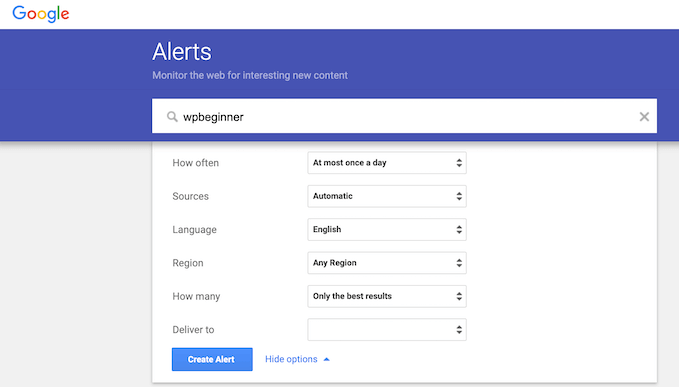
Next, choose ‘Sources’ from the menu and select ‘Blogs’ and ‘Web’. Then, hit ‘Create Alert’.
Now, you’ll get an email whenever your content pops up on the web or when your site is mentioned elsewhere online.
2. Manually Search for Stolen Content
Copyscape is a handy tool for checking plagiarism, which helps you find if your content has been published elsewhere on the web.
Just head over to Copyscape and enter your website URL. You can also input a specific post or page URL to check if your blog post or page has been copied.
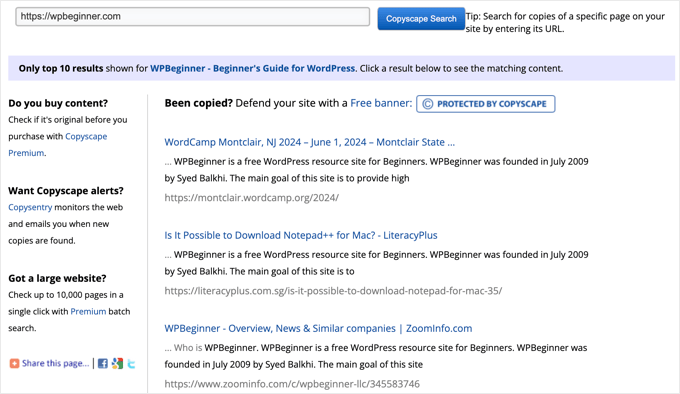
The free version displays the top 10 results, which is often plenty for smaller WordPress blogs.
If you have a larger site or want to catch every instance of copied text, consider upgrading to Copyscape Premium.
The premium version lets you scan up to 10,000 pages with one click. It’s perfect for websites with lots of content.
Another great tool is Grammarly, a popular online grammar-checker. Aside from using it to check for grammar mistakes, we also use it to check for plagiarized content.
With the premium version, you get a built-in plagiarism checker. Paste your content into Grammarly, and it will scan the internet for any matches.
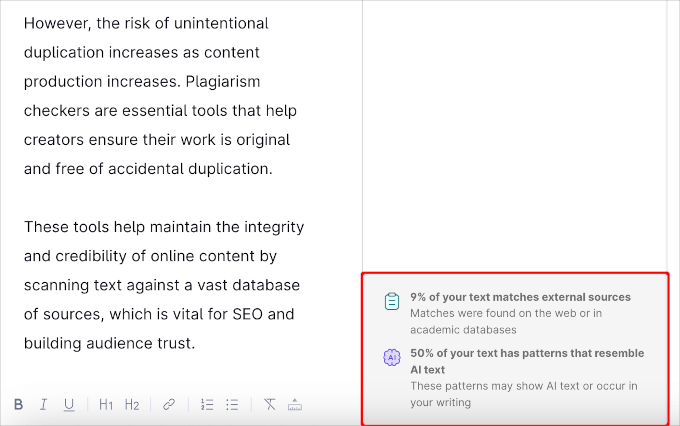
3. Contact the Offending Host or Registrar
So, you’ve discovered your content has been stolen. What should you do next?
One of the easiest ways to address this is by filing a Digital Millennium Copyright Act (DMCA) complaint against the offending site.
This legal notice requests the removal of copyrighted material that is being used without permission.
If the issue involves a spammy site or one that scrapes content from your RSS feed, finding contact info can be tricky.
But don’t worry, you can use the IsItWP lookup tool to identify where the domain and site are hosted.

Enter the domain hosting your stolen content and click ‘Analyze Website’.
This tool will reveal details like the web hosting company and registrar.
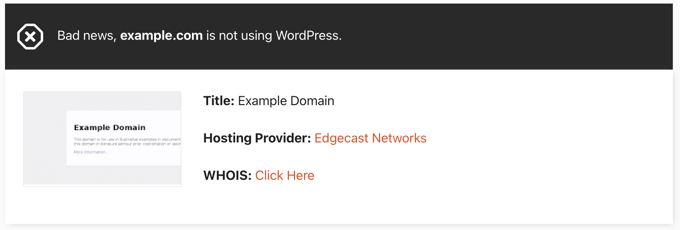
You’ll find the host and registrar information, even if the site isn’t using WordPress. Reach out to them directly to request content removal. Since content theft is illegal, most web hosts don’t want to support such activities.
Reputable web hosts take DMCA requests seriously and will help resolve the issue, possibly removing the violating content.
4. Submit a Takedown Notice to Google
If you want to remove stolen content from search results, you can contact Google directly.
Be cautious when using this method, as it requires solid proof. Filing false reports can get your account into trouble.
There are several ways to file a DMCA complaint with Google, but using the option in Google Search Console is recommended.
First, ensure your site is linked with Google Search Console. If not, check out our guide on how to add it.
After linking, you can use the Google Search Console Copyright Removal Tool.
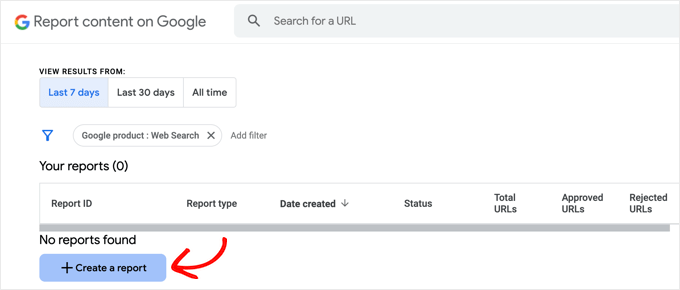
Click ‘Create a report’ and choose ‘New US DMCA report’ from the list.
This opens a form where you provide details like your contact info, the posts that were stolen, and the location of the stolen content.
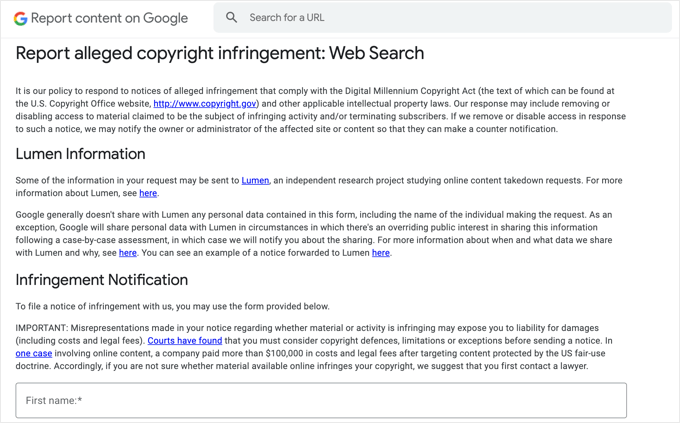
The more detail you include, the better your chances of getting the infringing site taken down.
If you need to gather additional evidence for your complaint, tools like the Wayback Machine can help.
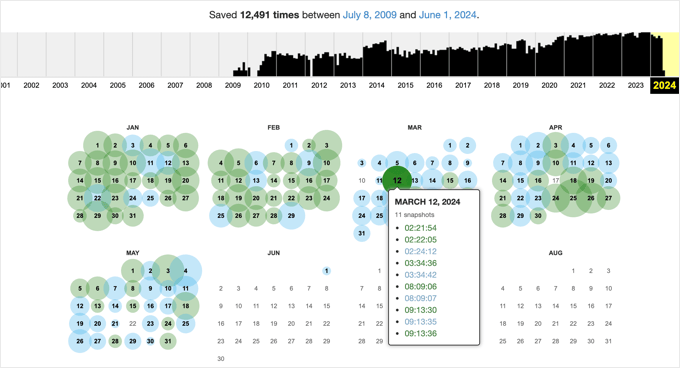
This tool captures snapshots of your site over time, allowing you to compare when you published your content against when the infringing site copied it.
5. Use an All-in-One Scanner and Takedown Tool
You can also use the DMCA tool to help you find duplicate content across the web.
Just enter your text or URL into the tool, and it will scour the web for sites that have stolen your content.
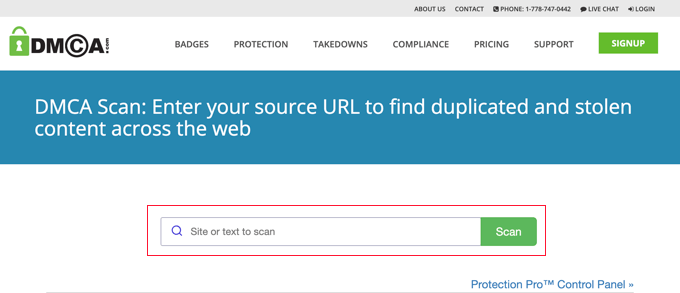
Note that the results won’t always be stolen content. It may sometimes be infographics, backlinks, unlinked brand mentions, and more.
Once you have found a site that plagiarized or stolen your content, you can start the takedown process using this same online tool.
DMCA offers premium takedown tools and templates for $10 per month. Or, you can purchase a full-service takedown for $199, where their team of experts will get your stolen content removed for you.
Final Thoughts on Dealing With Content Theft
Content theft is an issue that almost every website owner faces at some point. As your site grows, it’s likely that more people will start copying your work.
Some might blatantly steal your content using automated tools, while others may simply take inspiration and rephrase your ideas.
As a website owner, it can be incredibly frustrating to have your hard work taken without permission. Here at WPBeginner, we deal with this challenge regularly. Automated bot sites are usually straightforward to address with DMCA complaints.
However, as the largest WordPress resource site, we often see our headlines copied outright by other bloggers, theme providers, and even hosting companies. They might tweak the content to make it look original, but we recognize the influence of our articles.
We take this imitation as a form of flattery; it further validates that we are continuing to lead in the right way.
If a competitor is frequently drawing inspiration from you without directly copying, there’s often little you can do. Don’t let this discourage you. Instead, focus on your mission to serve your audience and keep innovating.
Expert Guides on Stolen Content & Copyright Infringement in WordPress
We hope this article helped you learn how to find and remove stolen content in WordPress. You may also want to see some other guides related to stolen content and copyright infringement in WordPress:
- Beginner’s Guide to Preventing Blog Content Scraping in WordPress
- How to Prevent Text Selection and Copy/Paste in WordPress (Easy)
- How to Add Image Credits in WordPress (Step by Step)
- How to Add No Right Click on WordPress Images
- How to Trademark and Copyright Your Blog’s Name & Logo
- How to Add a Dynamic Copyright Date in WordPress Footer
- Best Identity Theft Protection Services for Small Business
- The Ultimate WordPress Security Guide (Step by Step)
If you liked this article, then please subscribe to our YouTube Channel for WordPress video tutorials. You can also find us on Twitter and Facebook.





Moinuddin Waheed
This is very serious and ethical concern.
Your hardwork gets utilised by someone else and even without you knowing about the issue.
thank you for bringing this article to fight against the content theft.
I think it is very necessary to keep updated oneself with automatic content theft notifications.
and use cooyscrap and other tools to regularly check for any misuse of the content.
This will help bring such offences to minimum.
This article is very very useful for theft protection.
Olaf
This article could be an eye-opener for many. Why? Because a lot of people neglect proper security for their web content, assuming no one is interested enough to steal it. The opposite is often true. And there are many ways to protect content, whether through watermarks, better-protected RSS, disabling the right-click function, and more. If this issue does need addressing, it’s great that there’s a guide like this, explaining everything step-by-step. It can lessen the frustration over stolen content by showing exactly how to defend against it—and, most importantly, that it’s possible to protect yourself.
David Lim
I don’t understand why it’s a good thing to brag about other people’s content as if it’s our own. It can certainly be the easier way, but in many cases it ends very badly.
Jiří Vaněk
I occasionally use SEMRUSH backlinks to find stolen images. It can perfectly find sites that steal your images using so-called hotlinking. I recommend trying this method once in a while.